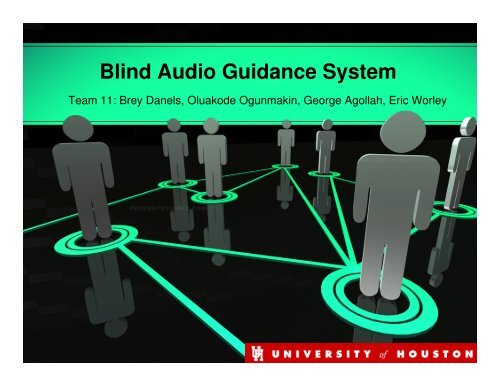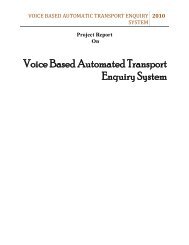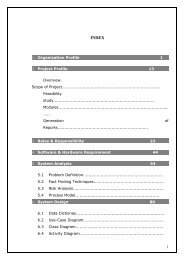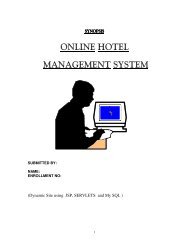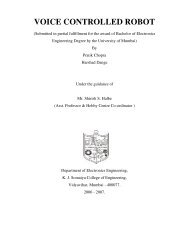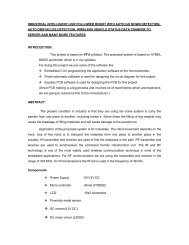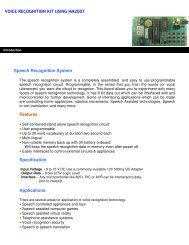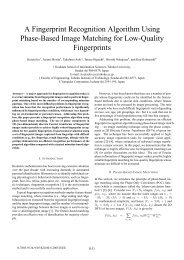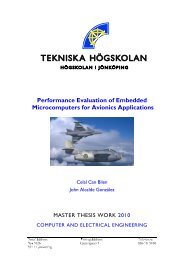Blind Audio Guidance System
Blind Audio Guidance System
Blind Audio Guidance System
You also want an ePaper? Increase the reach of your titles
YUMPU automatically turns print PDFs into web optimized ePapers that Google loves.
<strong>Blind</strong> <strong>Audio</strong> <strong>Guidance</strong> <strong>System</strong>Team 11: Brey Danels, Oluakode Ogunmakin, George Agollah, Eric Worley
OutlineIntroduction……………………….George AgollahBackground.………………………George AgollahObjectives…………………………George AgollahDesign Possibilities………….….George AgollahChallenges…………………Oluakode OgunmakinProject Description………Oluakode OgunmakinBlock Diagram…………….Oluakode OgunmakinCircuit Schematic…..…….Oluakode OgunmakinPowering the Device…………………Eric WorleyInitial Construction………Oluakode OgunmakinFinal Circuit/Prototype….Oluakode OgunmakinFuture Final Product………………..Brey DanelsDemonstration Description………..Brey DanelsSoftware Flowchart………………….Brey DanelsTesting/Verification…………………Brey DanelsDesign Constraints………………….Brey DanelsMarketing and Social Impact………Eric WorleyCost…………………………………….Eric WorleyQuestions………………………All team members<strong>Blind</strong> <strong>Audio</strong> <strong>Guidance</strong> <strong>System</strong>
Introduction<strong>Blind</strong> <strong>Audio</strong> <strong>Guidance</strong> <strong>System</strong>: Slide 1 There are approximately 21.2 million blind orvisually impaired people in the U.S. alone. Currently most blind people rely on other people,dogs, and their canes to find their way in buildings. This can be a hassle for both the visuallyimpaired person as well as others. Many disabled people prefer to do thingsindependently rather than rely on others. The <strong>Blind</strong> <strong>Audio</strong> <strong>Guidance</strong> <strong>System</strong> can provide asolution to this problem.
Background<strong>Blind</strong> <strong>Audio</strong> <strong>Guidance</strong> <strong>System</strong>: Slide 2Current Patents and Existing Technologies: Smart Canes – provide obstacle detection Sonar vision glasses – also may provide obstacle detection GPS navigation systems – provide directions, but not reliable or accurateenough for use in buildingsThe <strong>Blind</strong> <strong>Audio</strong> <strong>Guidance</strong> <strong>System</strong> would allow navigation inside of buildings.
Project Objectives<strong>Blind</strong> <strong>Audio</strong> <strong>Guidance</strong> <strong>System</strong>: Slide 3 The main goal of the project is to provide a cost-effective way to allowbuildings to support blind people. The <strong>Blind</strong> <strong>Audio</strong> <strong>Guidance</strong> <strong>System</strong> hopes to allow visually impaired users tosimply press a button, speak the desired destination, and be guided there withthe use of audio instructions. The system hopes to provide a portable unit that can easily be carried andoperated by a visually impaired user. It could easily be incorporated into awalking cane.
Design Possibilities<strong>Blind</strong> <strong>Audio</strong> <strong>Guidance</strong> <strong>System</strong>: Slide 4Many different design possibilities were explored during research. Wireless Sensor Networks – Due to the high amount of sensors requiredfor large buildings, this may be impractical, especially when user directionmust be tracked. Programming would be much more complex. RSSI Techniques – This can be effective at finding distances base onsignal strength but is also affected by the direction problem. RFID – Seems to provide the most cost effective and simplest way todetermine direction using the technique that the team has developed. Theprogramming using this technique would also be less complex.
Challenges<strong>Blind</strong> <strong>Audio</strong> <strong>Guidance</strong> <strong>System</strong>: Slide 5 Low cost RFID readers have a short read range. Long range readers require more power and cost much more. Portability is difficult if high power is needed. RFID tag reads and read ranges may be inconsistent. RFID cannot inherently determine direction of approach. Speech recognition may be problematic due to unwanted noise and falsereads.
Project DescriptionMajor Hardware Components:•MINI-MAX/51 Microcontroller<strong>Blind</strong> <strong>Audio</strong> <strong>Guidance</strong> <strong>System</strong>: Slide 6•EMIC Text-To-Speech Module•SR-07 Speech Recognition Kit•Headset (microphone/speaker)•Parallax RFID Reader
Block Diagram<strong>Blind</strong> <strong>Audio</strong> <strong>Guidance</strong> <strong>System</strong>: Slide 7
Circuit Schematic<strong>Blind</strong> <strong>Audio</strong> <strong>Guidance</strong> <strong>System</strong>: Slide 8
Powering the Device<strong>Blind</strong> <strong>Audio</strong> <strong>Guidance</strong> <strong>System</strong>: Slide 9The <strong>Blind</strong> <strong>Audio</strong> <strong>Guidance</strong> <strong>System</strong> is clearly a device that would need to have theability to be powered for a sufficient amount of time throughout the day.• Team 11 has decided to use a 6v 10,000mAHNi-MH (nickel metal hydride) battery pack topower the device.• Unlike Ni-Cd (nickel cadmium) batterieswhich are the most commonly used batteries inthe world for devices such as remote controls,flash lights, RC cars etc; Ni-MH batteries havehigher capacities than Ni-Cd, better dischargerates, and are not affected by the “memoryeffect”.
Powering the Device contd…<strong>Blind</strong> <strong>Audio</strong> <strong>Guidance</strong> <strong>System</strong>: Slide 10CalculationsRFID - 10mA idle 100mA active8051 - 50mAText to speech – 70mASpeech recognition – 70mAThe above are the amps drawn from each component that are assembled together to make the <strong>Blind</strong><strong>Audio</strong> <strong>Guidance</strong> <strong>System</strong>. The following is a theoretical calculation of how long team 11’s 6v Ni-MH10,000mAH will power the device.Worst Case Total Amps Used – 290mABattery – 10,000mAHBattery capacity (milliamp hours) / total current (milliamp) = battery life (hours)Theoretical Battery Life – 10,000mAH / 290mA = 34.48 HoursThis clearly is more than acceptable for the amount of time that the device will be able to operate. Team11 decided to go with a little more milliamp hours than necessary for the convenience to allow a blindindividual to possibly use the device two to three days without the need for a recharge.
Initial Construction<strong>Blind</strong> <strong>Audio</strong> <strong>Guidance</strong> <strong>System</strong>: Slide 11
Final Circuit<strong>Blind</strong> <strong>Audio</strong> <strong>Guidance</strong> <strong>System</strong>: Slide 12
Final Prototype<strong>Blind</strong> <strong>Audio</strong> <strong>Guidance</strong> <strong>System</strong>: Slide 13
Future Final Product<strong>Blind</strong> <strong>Audio</strong> <strong>Guidance</strong> <strong>System</strong>: Slide 14
Actual Demonstration<strong>Blind</strong> <strong>Audio</strong> <strong>Guidance</strong> <strong>System</strong>: Slide 15
Building Implementation<strong>Blind</strong> <strong>Audio</strong> <strong>Guidance</strong> <strong>System</strong>: Slide 16
Software Flowchart<strong>Blind</strong> <strong>Audio</strong> <strong>Guidance</strong> <strong>System</strong>: Slide 17
Testing Code<strong>Blind</strong> <strong>Audio</strong> <strong>Guidance</strong> <strong>System</strong>: Slide 18Testing Code for RFID InputActual Code for RFID Input
Testing Code<strong>Blind</strong> <strong>Audio</strong> <strong>Guidance</strong> <strong>System</strong>: Slide 19Testing Code for Text-to-Speech OutputTesting Code Speech Recognition Input
Testing Procedure<strong>Blind</strong> <strong>Audio</strong> <strong>Guidance</strong> <strong>System</strong>: Slide 20
Design Constraints Must be portable (size and power) Affordable for most users and businesses<strong>Blind</strong> <strong>Audio</strong> <strong>Guidance</strong> <strong>System</strong>: Slide 21 Cost must be kept down to a minimum while maintaining full functionality Programming as well as hardware must be kept as simple as possible dueto time constraints Previous location tags should not be within read range of direction outputtags Tags will be placed on the floor, and the reader must be within range
Marketing and Social Impact As mentioned previously with 21.2 million visuallyimpaired people in the United States alone, it would besmart for businesses to cater to their needs. The use of RFID technology can help to do this at alower cost than most other technologies on the markettoday. This system would give the visually impaired anopportunity to integrate with society more easily. These people would have a greater sense ofindependence.<strong>Blind</strong> <strong>Audio</strong> <strong>Guidance</strong> <strong>System</strong>: Slide 22
Cost<strong>Blind</strong> <strong>Audio</strong> <strong>Guidance</strong> <strong>System</strong>: Slide 23Cost AnalysisTable 1: Component CostPARTS DESCRIPTION Quantity ESTIMATED COSTMINI-MAX/51-C2* Microcontroller 1 $70.00Parallax EMIC TTS** Text to Speech Module 1 **$80.00Parallax 125MHz RFID Module** RFID Tag Reader 1 **$40.00HM2007 Speech Recognition Kit** Speech Recognition Kit 1 $179.00Parallax 12MHz Transponder RFID Tag 100 $62.00<strong>Audio</strong> Control Module 2.5mm jack 1 $5.00Miscellaneous Miscellaneous --- $30.0010,000mah NiMH Battery** 6v Rechargeable battery 1 **$51.50MRC Super Brain 960** AC/DC Delta Peak Charger 1 **$58.00Total Donations ------------ --- -$229.50* PARTS AQUIRED** PARTS DONATEDTOTAL $346.00
Questions<strong>Blind</strong> <strong>Audio</strong> <strong>Guidance</strong> <strong>System</strong>: Slide 24


